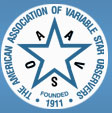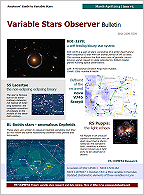Variable Stars Common Observation
Mission in Particular Areas of the Sky
Public Photometry Resources
Photometric surveys are essential for variable stars science. Nowadays an individual may access publicly available photometry sources for a research instead of maintaining own one. This provides some advantages and allows a "fast start" though an user is restricted to only a data gathered during a pre-defined period in the past.
There is also a challenging task: since available data belongs to a period in the past (sometimes years ago), it is possible to build a light curve with own equipment and try to enhance a variability period significantly. Being scattered over hundreds or even thousands of possible period cycles apart, the data may be improved and have a stronger quality. This reveals a huge field for automatic research available even to amateur astronomers.
Here at VS-COMPAS we also use public online services as a photometry source. Combining all available data for an object is an important phase of a research. Since every survey may have its own data format and access options, it usually takes quite a bit of time to combine data from different surveys into one light curve manually. Our software photometry aggregation and processing tool does this smoothly and pain-free, significantly reducing time we would spend on data joining.
There are several useful online photometry source outside.
 Northern Sky Variability Survey (NSVS)
Northern Sky Variability Survey (NSVS)
The Northern Sky Variability Survey (NSVS) is a temporal record of the sky over the optical magnitude range from 8 to 15.5. It was conducted in the course of the first generation Robotic Optical Transient Search Experiment (ROTSE-I) using a robotic system of four co-mounted unfiltered telephoto lenses equipped with CCD cameras. The survey was conducted from Los Alamos, NM, and primarily covers the entire northern sky. Some data in southern fields between declinations 0 and -38 deg is also available, although with fewer epochs and noticeably lesser quality. The NSVS contains light curves for approximately 14 million objects. With a one year baseline and typically 100-500 measurements per object, the NSVS is one of the most extensive records of stellar variability across the bright sky available today. The database provides a cone search interface and online access to light curves.
Website: NSVS Online Database
Publications: Northern Sky Variability Survey: Public Data Release
 All Sky Automated Survey (ASAS)
All Sky Automated Survey (ASAS)
The All Sky Automated Survey (ASAS) is a low cost Polish project dedicated to constant photometric monitoring of the whole available sky. The project's ultimate goal is detection and investigation of of any kind of the photometric variability. One of the main obectives of ASAS is to find and catalog variable stars. ASAS is implemented on 7 April 1997 to do photometric monitoring of approximately 20 million stars brighter than 14 magnitude all over the sky. The automatic telescopes discovered two new comets in 2004 and 2006. The ASAS-South, located in Chile and ASAS-North, located in Hawai'i, are managed by Grzegorz Pojmanski of the Warsaw University Observatory via the internet.
Website: ASAS Home Page
Publications: ASAS Publications, Wiki: ASAS Papers
 Catalina Real-Time Transient Survey (CRTS)
Catalina Real-Time Transient Survey (CRTS)
The Catalina Real-Time Transient Survey is a synoptic astronomical exploration that covers thirty three thousand square degrees of the sky in order discover rare and interesting transient phenomina. The survey utilizes data taken by the three dedicated telescopes of the highly successful Catalina Sky Survey (CSS) NEO project. CRTS detects and openly publishes all transients within minutes of observation so that all astronomers may follow ongoing events. CRTS builds on the work performed for the Palomar Quest survey and continues to pave the way for deeper upcoming transient surveys (LSST), by automating the event discovery and classification processes so that robust decisions can enable intelligent human and robotic follow up.
Website: CRTS Home Page
Publications: CRTS Publications, CRTS Research Areas
 The AAVSO Photometric All-Sky Survey (APASS)
The AAVSO Photometric All-Sky Survey (APASS)
APASS is an all-sky photometric survey and a public service to the astronomical community. It was funded through generous contributions from the Robert Martin Ayers Sciences Fund and the AAVSO endowment. Data release 1 of APASS occurred on 2010 September 10, and contained photometry for approximately four million stars distributed among several hundred discrete fields between -10.15 < Dec < +87.35. Data release 2 occurred on 2011 February 10, and included an additional four million stars from the southern hemisphere, acquired from our site at CTIO. Data Release 3 occurred on 2011 August 10, and further extended southern hemisphere coverage. Data Release 4 occurred in early January 2012. Data Release 5 then occurred on 2012 February 21, and Data Release 6 occurred on 2012 June 8. We expect the next data release in 2013. The catalog now contains photometry for 42 million objects in about 95% of the sky.
Website: APASS Home Page
Publications: ADS: AAVSO Photometric All-Sky Survey Implementation at the Dark Ridge Observatory
 Kepler Input Catalog (KIC)
Kepler Input Catalog (KIC)
The Kepler Input Catalog (or KIC) is a publicly searchable database of roughly 13.2 million targets used for the Kepler Spectral Classification Program (SCP) and Kepler. The Kepler Mission, is specifically designed to survey our region of the Milky Way galaxy to discover hundreds of Earth-size and smaller planets in or near the habitable zone and determine how many of the billions of stars in our galaxy have such planets. The KIC, or Kepler Input Catalog, is the primary source of information about objects observed as part of the ground-based Kepler Spectral Classification Program (SCP) in preparation for the selection of Kepler PI and GO targets. The KIC lists objects down to 21mag, but it is not complete to this limit. Light from only about 1/3 of these objects falls on the Kepler CCD detector.
Website: Kepler Input Catalog at MAST, Kepler at NASA, Kepler Input Catalog Links
Publications: Kepler Papers
 Lincoln Near-Earth Asteroid Research (LINEAR)
Lincoln Near-Earth Asteroid Research (LINEAR)
Lincoln Near Earth Asteroid Research (LINEAR) is an MIT Lincoln Laboratory program funded by the United States Air Force and NASA. The goal of LINEAR is to demonstrate the application of technology originally developed for the surveillance of Earth orbiting satellites, to the problem of detecting and cataloging near - Earth asteroids — also referred to as near-Earth objects (NEOs) — that threaten the Earth. As a by-product, there is a stellar photometry available. Nearly 5 billion photometric measurements for more than 24 million objects covering a time baseline of about 7 years. SDSS identifications for most objects are provided.
Website: LINEAR Online Database, LINEAR at NASA JPL
Publications: LINEAR Papers
Obviously, there are more surveys will be conducted in the near future. The presented list of surveys should serve as a good starting point for amateur variable stars researchers.
 Issue #5
Issue #5
March-April 2014
Free Online
PDF Bulletin on Variable Stars
Amateurs' Guide to Variable Stars
Read Online as e-Magazine
In this issue:
 by Ivan Adamin
by Ivan Adamin
BL Bootis stars - anomalous Cepheids
 by Ivan Adamin
by Ivan Adamin
A revision of NSV 13538 = NSVS 17231162
 by Alexandr Ditkovsky
by Alexandr Ditkovsky
NSVS 11075037 = Dauban V53:
updated elements of a Mira variable in Hercules
 by Siarhey Hadon
by Siarhey Hadon
RS Puppis: the light echoes calibrate standard candles for accurate distance measurements
 by Ivan Adamin
by Ivan Adamin
SS Lacertae: The non-eclipsing eclipsing binary
 by Ivan Adamin
by Ivan Adamin
>>View Full Contents

|
Statistics Overview
Variables by Type Variables by Magnitude Variables by Period Build Own Criteria |
